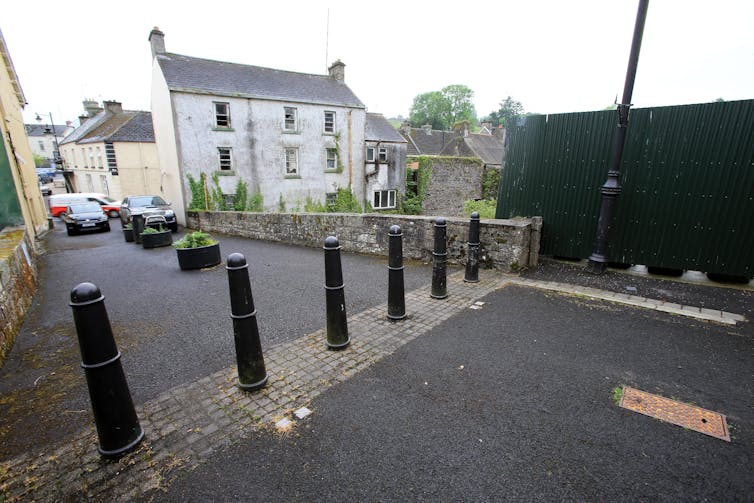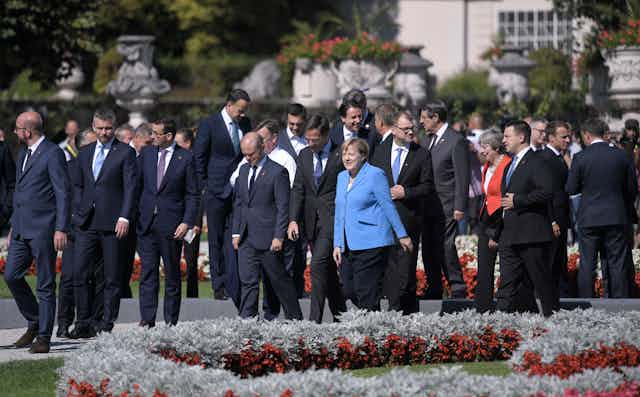Despite the hype from some in the UK, very few observers expected a Brexit breakthrough at the EU’s Salzburg summit on September 20. Still, EU and Irish officials were surprised when the UK prime minister, Theresa May, told her Irish counterpart Leo Varadkar that her government would not have a detailed legal text on the Irish border issue ready by the next meeting of EU leaders in October.
Although the UK government had put forward proposals for a legal “backstop” to avoid a hard border between Ireland and Northern Ireland back in June, the EU and the Irish government had requested – and expected – more detail.
This apparently led the French president, Emmanuel Macron, to tear up his conciliatory speech to May and deliver a more hardline one. This speech, and the forthright rejection by European Council President Donald Tusk of May’s Chequers plan for the EU-UK relationship after Brexit, resulted in an equally hardline statement from May upon her return to London in which she asked the EU to spell out its alternative. Varadkar commented that negotiations had entered a “rocky patch”.
The core issues have changed little since the UK voted to leave the EU in June 2016. The EU continues to prioritise protecting a soft border between Northern Ireland and Ireland, and it holds firm to the condition that the UK must agree the text of a legal backstop that would prevent a hard border in Ireland in all circumstances.
Ireland and the EU also hold firm that the four freedoms of the single market – freedom of movement of people capital, goods and services – must not be undermined by a withdrawal agreement. However, they argue that single market rules could apply to Northern Ireland only, not the whole of the UK, because of Northern Ireland’s special situation as a post-conflict area and because of the primacy of the Good Friday Agreement in maintaining peace.
For the UK government, propped up in Westminster by the Northern Irish Democratic Unionist Party (DUP), maintaining single market membership for the island of Ireland, but not for the UK as a whole, would undermine the constitutional integrity of the UK.

Looking for solutions
For the EU and the Irish government, the only way to protect a soft border between Northern Ireland and Ireland, which preserves the integrity of the EU’s single market is to have customs controls between Northern Ireland and Britain – essentially a border within the Irish sea. This could ensure that goods originating from Britain do not seep into EU markets, via Northern Ireland and Ireland, undercutting EU prices and bypassing EU regulations.
The head of the EU Commission’s Brexit task force, Michel Barnier, signalled his intention of “de-dramatising” the border issue. In the week before the Salzburg summit, he proposed that customs checks could take place at designated places in Britain of certain goods and that technical solutions could be found that would minimise explicit border controls at UK ports. In addition, the EU emphasised that there were already controls between Northern Ireland and Britain in areas of animal health and agri-food.
The EU’s proposal reflects the Irish government’s position that a soft border must be preserved and that Northern Ireland is already treated differently from other parts of the UK. The EU and the Irish government think the DUP is most definitely over-dramatising the significance of a sea border. Simon Coveney, Ireland’s minister for foreign affairs, said the DUP should not have a veto on the backstop agreement. If the UK provides a draft detailed text on the Irish border, the Irish government and the EU have indicated that they could provide a flexible approach.
The Irish response
The imminent problem with achieving flexible, bespoke solutions is that the extent of bad feeling shown in Salzburg makes it hard for any compromises to be reached quickly in time for the next EU summit on October 19.
Some in Dublin still hold out hope that after the Conservative Party conference in late September, May will deliver a compromise. But the Irish government is deeply concerned that time is running out and there are serious fears that no agreement will be reached.

In the wake of the Salzburg summit, there were immediate efforts from the Irish government to ameliorate tensions. Coveney told RTE radio that May had promised to produce a new legal text on the backstop and that he still felt progress could be made for the October summit.
Ireland’s opposition Fianna Fail party – which is in a confidence and supply arrangement with the governing Fine Gael party – argued that the EU should have been more positive about the Chequers proposal so as to give May some bargaining space. The EU’s approach, Fianna Fail argued, made it harder for May to compromise given the divisions within her party.
The view from Dublin has become more pessimistic. Diplomats and politicians will seek to limit the damage from the Salzburg summit, but there is a keen awareness that time is running out and that May must deliver a text on the backstop. Hopefully, the EU will extend a symbolic olive branch to May and avoid any more hardline rhetoric during this fragile period. Hopefully, she will reciprocate after the Conservative Party conference. If so, a deal could still be possible, if not fully finalised by October 19 – though it’s by no means certain.

